B&MR: Brecon and Merthyr Railway
|
construction, 1863
|
| The Brecon and Merthyr Tydfil Junction Railway (B&MR) was a railway company in Wales. It was originally intended to link the towns in its name. Finding its access to Merthyr difficult at first, it acquired the Rumney Railway, an old plateway, and this gave it access to Newport docks. This changed its emphasis from rural line to mineral artery. It opened at the Brecon end to a point near Dowlais in 1863, and in 1865 it opened a disconnected section from Rhymney to Newport. In due course the company connected the two sections and reached Dowlais and Merthyr, but had to concede sharing a route with the powerful London and North Western Railway. The B&MR was always short of money, and was notable for its prodigious gradients, but it survived until the grouping of 1923, when it became part of the Great Western Railway. Its network declined steeply after 1945, and passenger operation ceased in 1962. Goods and mineral operation also lost its market, and as of 2020, only a short stub to a quarry at Machen remains rail connected.
Click here for full Wikipedia article
Map
|
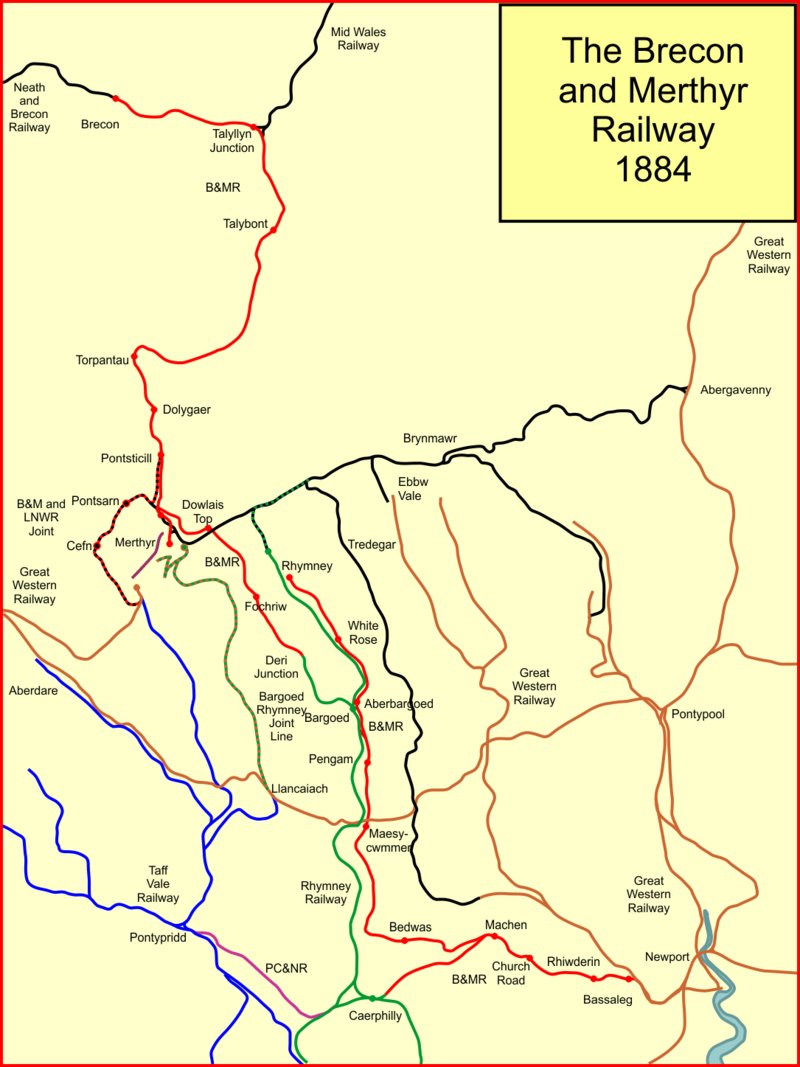
Image Source: Afterbrunel - Own work
|
BD: Barry Docks
|
construction, 1884
|
| The Barry Railway Company was a railway and docks company in South Wales, first incorporated as the Barry Dock and Railway Company in 1884. It arose out of frustration among Rhondda coalowners at congestion and high charges at Cardiff Docks as well the monopoly held by the Taff Vale Railway in transporting coal from the Rhondda. In addition, the Taff Vale did not have the required capacity for the mineral traffic using the route, leading to lengthy delays in getting to Cardiff.
Click here for full Wikipedia article
|
![]()
Image Source:
|
BR: Barry railway
|
construction, 1884
|
| (see article on Barry Docks)
Click here for full Wikipedia article
|
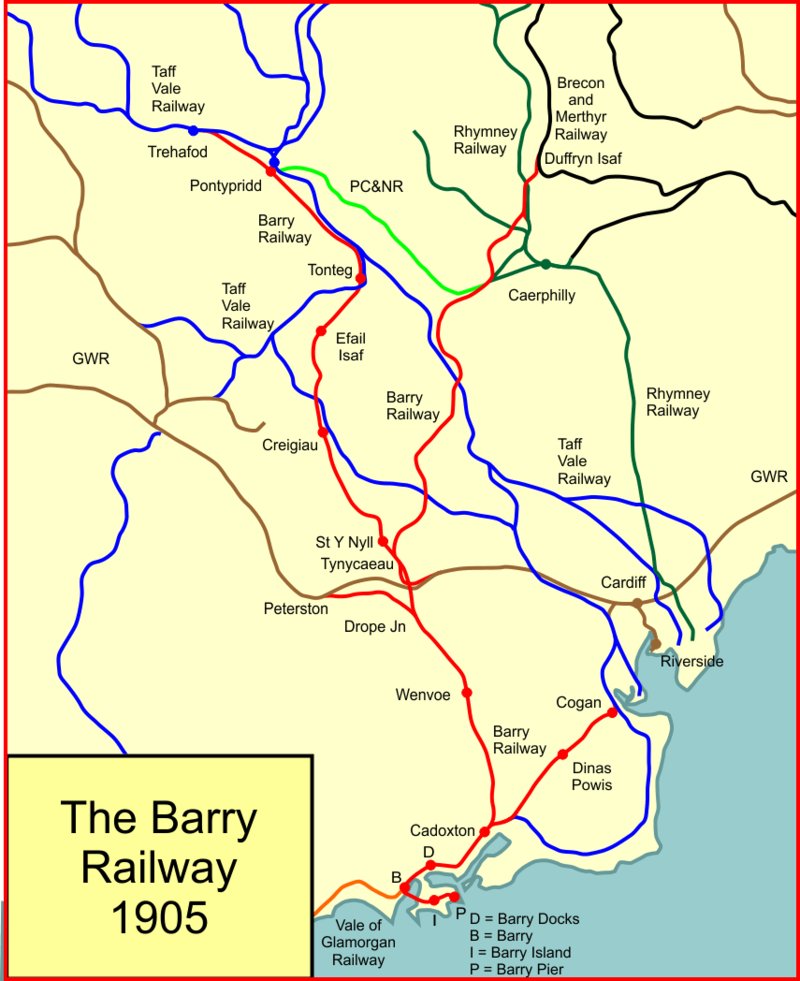
Image Source: Afterbrunel - Own work
|
BR(M): British Railways (Midland region)
|
nationalisation, 1948
|
| The London Midland Region (LMR) was one of the six regions created on the formation of the nationalised British Railways (BR), and initially consisted of ex-London, Midland and Scottish Railway (LMS) lines in England and Wales. The region was managed first from buildings adjacent to Euston station, and later from Stanier House in Birmingham. It existed from the creation of BR in 1948, ceased to be an operating unit in its own right in the 1980s, and was wound up at the end of 1992.
Click here for full Wikipedia article
|
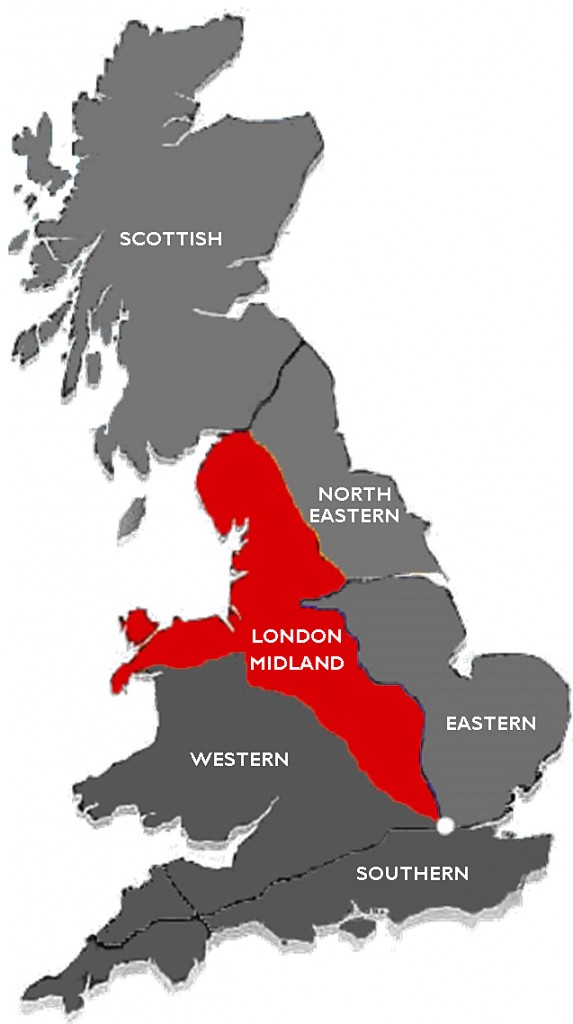
Image Source: open source
|
BR(S): British Railways (Southern region)
|
nationalisation, 1948
|
| The Southern Region was a region of British Railways from 1948 until 1992 when railways were re-privatised. The region ceased to be an operating unit in its own right in the 1980s. The region covered south London, southern England and the south coast, including the busy commuter belt areas of Kent, Sussex and Surrey. The region was largely based upon the former Southern Railway area.
Click here for full Wikipedia article
|
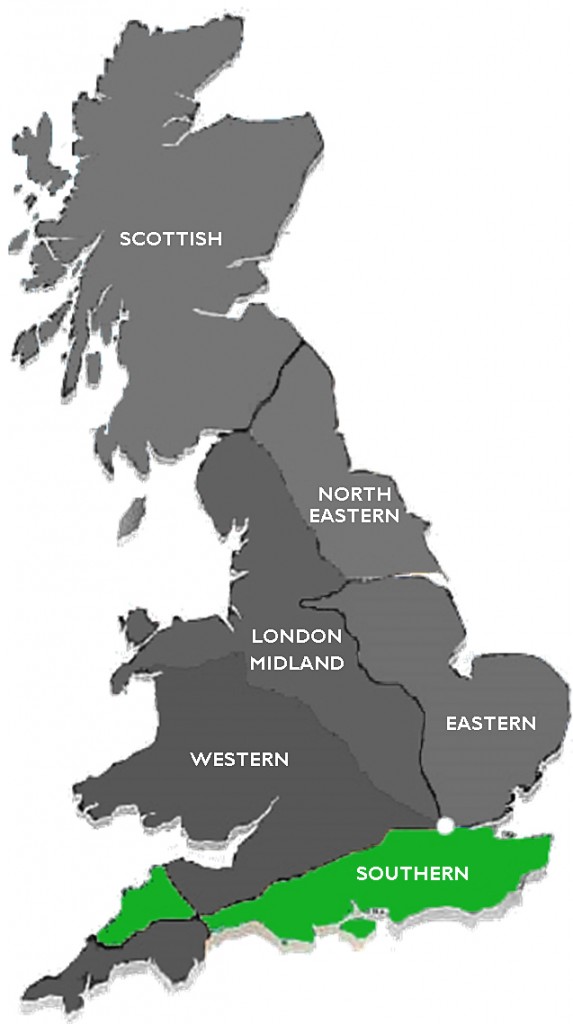
Image Source: open source
|
CLC: Cheshire Lines Committee
|
merger, 1860
|
| The Cheshire Lines Committee (CLC) was formed in the 1860s and became the second-largest joint railway in Great Britain. The committee, which was often styled the Cheshire Lines Railway, operated 143 miles (230 km) of track in the then counties of Lancashire and Cheshire. The railway did not get grouped into one of the Big Four during the implementation of the 1923 grouping, surviving independently with its own management until the railways were nationalised at the beginning of 1948. The railway served Liverpool, Manchester, Stockport, Warrington, Widnes, Northwich, Winsford, Knutsford, Chester and Southport with connections to many other railways.
Click here for full Wikipedia article
|
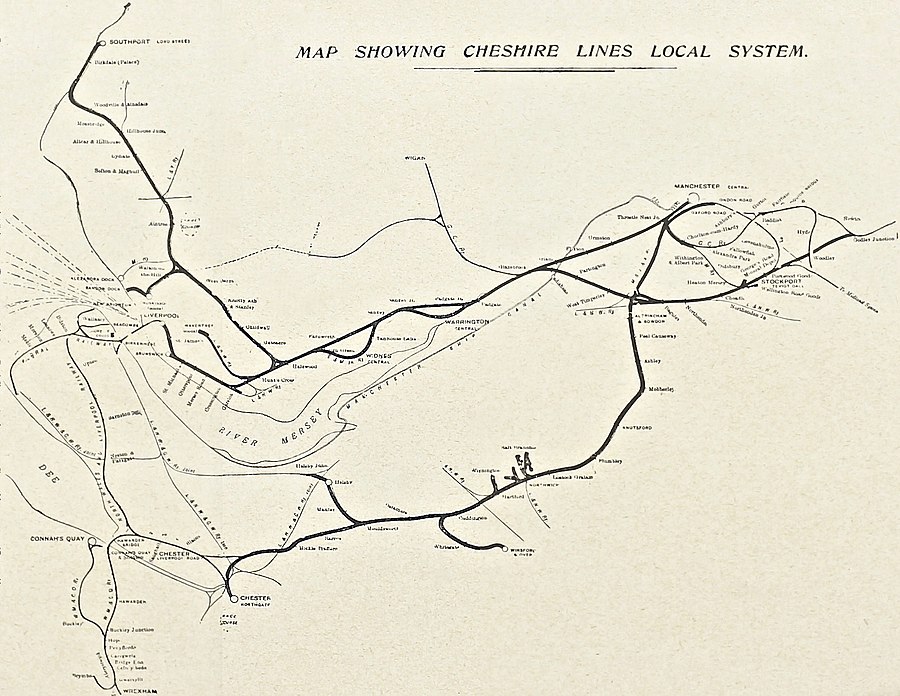
Image Source: public domain
|
DR: District railway
|
construction, 1864
|
| The Metropolitan District Railway (commonly known as the District Railway) was a passenger railway that served London from 1868 to 1933. Established in 1864 to complete the inner circle, an underground railway in London, the first part of the line opened using gas-lit wooden carriages hauled by steam locomotives. The Metropolitan Railway operated all services until the District introduced its own trains in 1871. The railway was soon extended westwards through Earl's Court to Fulham, Richmond, Ealing and Hounslow. After completing the inner circle and reaching Whitechapel in 1884, it was extended to Upminster in Essex in 1902.
Click here for full Wikipedia article
|
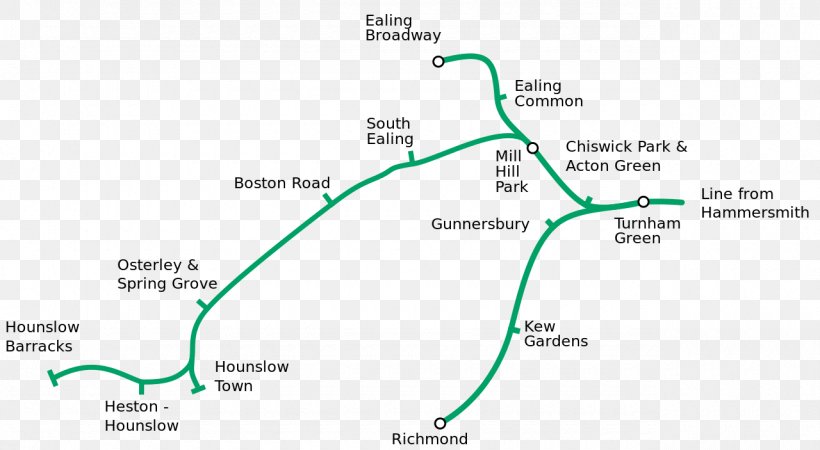
Image Source: Creative Commons Attribution-Share Alike 3.0 Unported
|
G&SWR: Glasgow and Southwest Railway
|
merger, 1850
|
| The Glasgow and South Western Railway (G&SWR) was a railway company in Scotland. It served a triangular area of south-west Scotland between Glasgow, Stranraer and Carlisle. It was formed on 28 October 1850 by the merger of two earlier railways, the Glasgow, Paisley, Kilmarnock and Ayr Railway and the Glasgow, Dumfries and Carlisle Railway. Already established in Ayrshire, it consolidated its position there and extended southwards, eventually reaching Stranraer. Its main business was mineral traffic, especially coal, and passengers, but its more southerly territory was very thinly populated and local traffic, passenger and goods, was limited, while operationally parts of its network were difficult.
Click here for full Wikipedia article
|

Image Source: Afterbrunel - Own work
|
GCR: Great Central Railway
|
merger, 1897
|
| The Great Central Railway in England came into being when the Manchester, Sheffield and Lincolnshire Railway changed its name in 1897, anticipating the opening in 1899 of its London Extension.[1] On 1 January 1923, the company was grouped into the London and North Eastern Railway.
Click here for full Wikipedia article
|
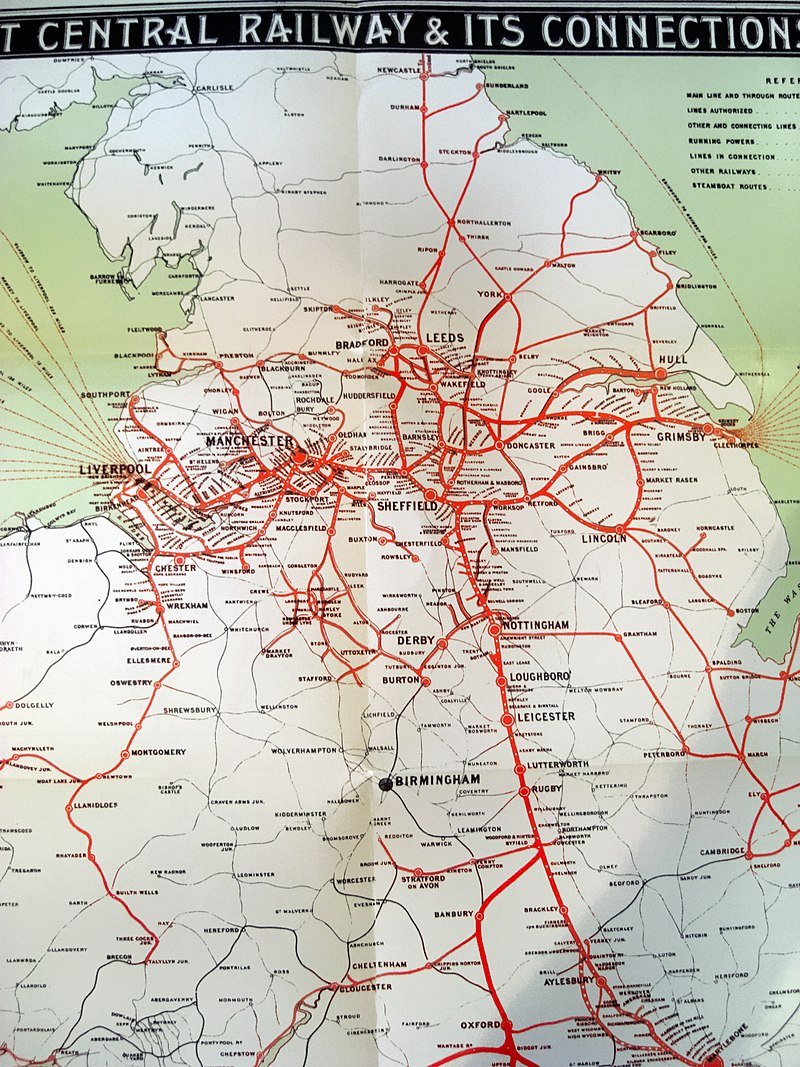
Image Source: By Jozg44 - Own work, Public Domain, https://commons.wikimedia.org/w/index.php?curid=4642478
|
GER: Great Eastern Railway
|
merger, 1862
|
| The Great Eastern Railway (GER) was a pre-grouping British railway company, whose main line linked London Liverpool Street to Norwich and which had other lines through East Anglia. The company was grouped into the London and North Eastern Railway in 1923. Formed in 1862 after the amalgamation of the Eastern Counties Railway and several other smaller railway companies the GER served Cambridge, Chelmsford, Colchester, Great Yarmouth, Ipswich, King's Lynn, Lowestoft, Norwich, Southend-on-Sea (opened by the GER in 1889), and East Anglian seaside resorts such as Hunstanton (whose prosperity was largely a result of the GER's line being built) and Cromer.[1] It also served a suburban area, including Enfield, Chingford, Loughton and Ilford. This suburban network was, in the early 20th century, the busiest steam-hauled commuter system in the world.
Click here for full Wikipedia article
|
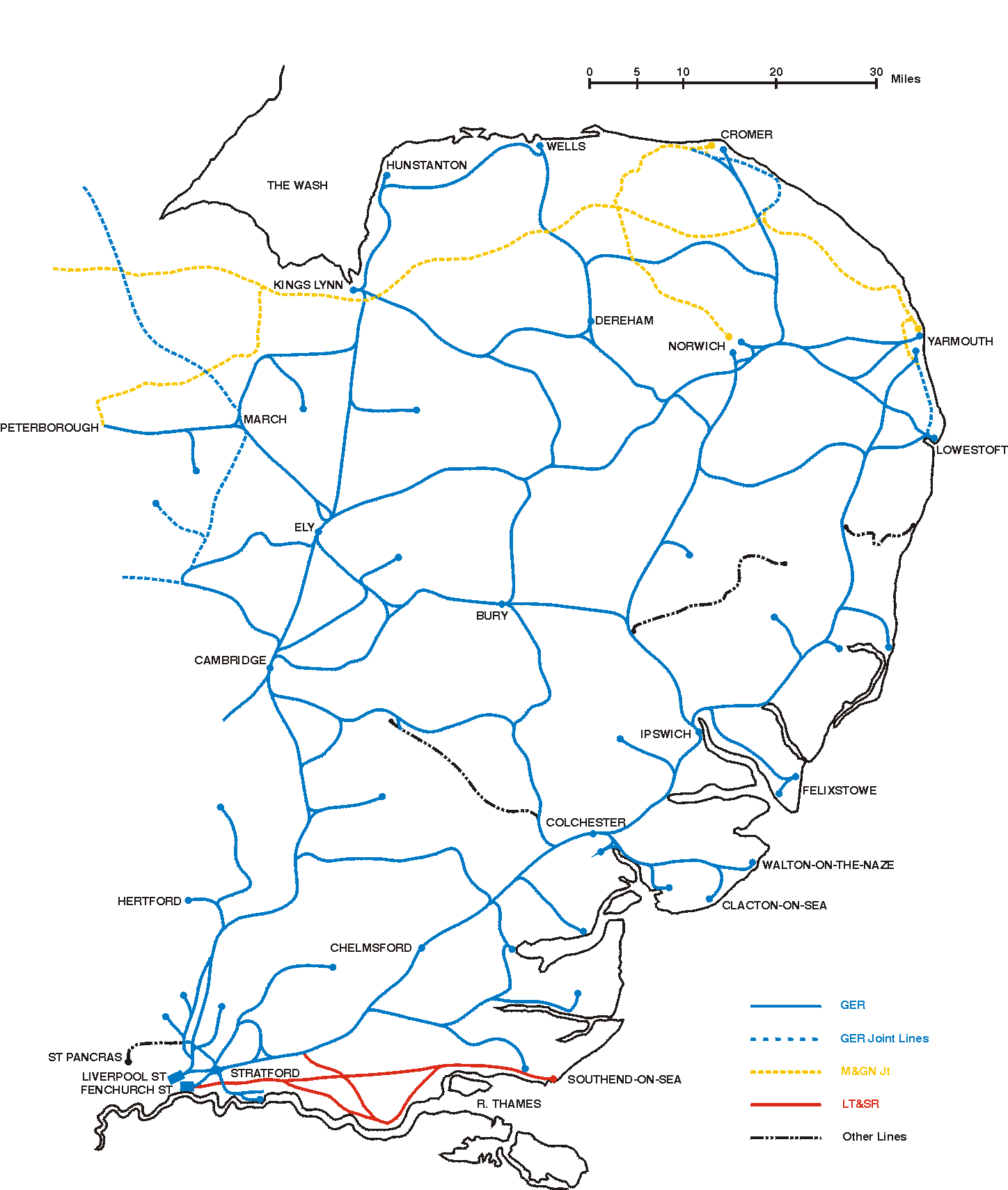
Image Source: public domain
|
GN&GER: Gt Northern and GT Eastern Railway
|
merger, 1879
|
| The Great Northern and Great Eastern Joint Railway, colloquially referred to as "the Joint Line"[1] was a railway line connecting Doncaster and Lincoln with March and Huntingdon in the eastern counties of England. It was owned jointly by the Great Northern Railway and the Great Eastern Railway. It was formed by transferring certain route sections from the parent companies, and by the construction of a new route between Spalding and Lincoln, and a number of short spurs and connections. It was controlled by a Joint Committee, and the owning companies operated their own trains with their own rolling stock. The Joint Line amounted to nearly 123 miles of route. on 3 July 1879 the Parliamentary Bill authorising the Joint Line was passed.
Click here for full Wikipedia article
|
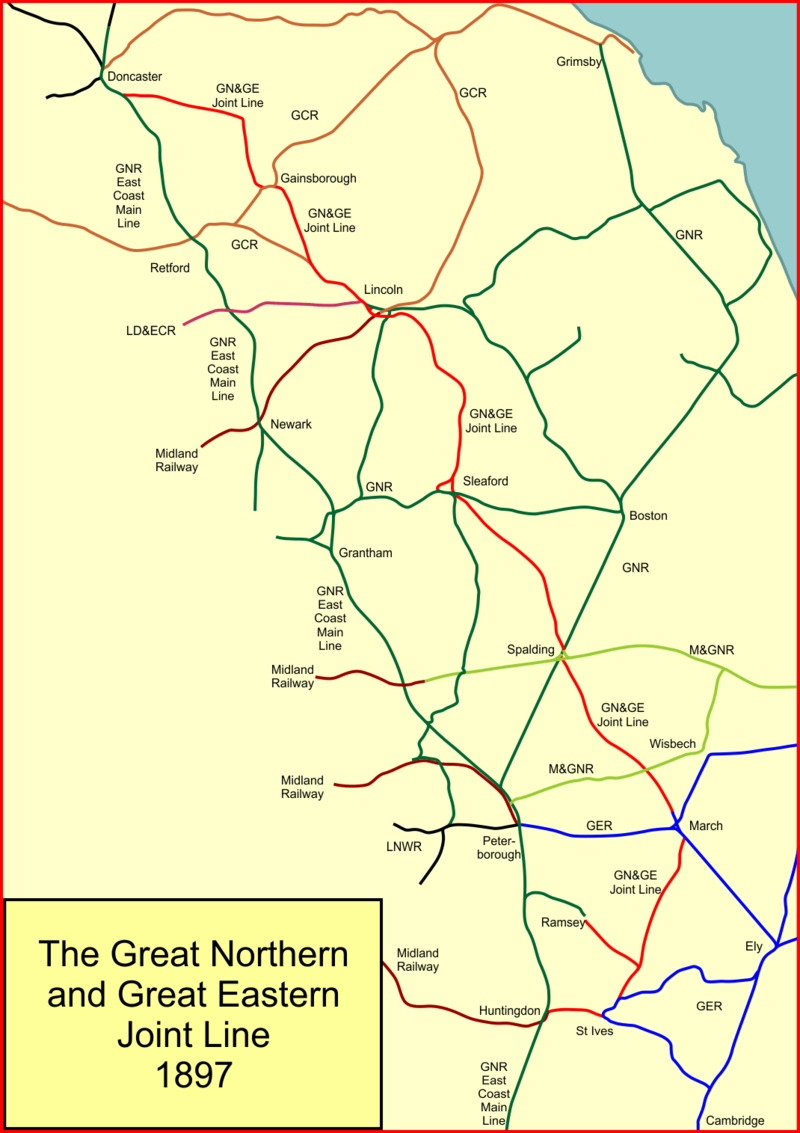
Image Source: public domain
|
GNR: Great Northern Railway
|
construction, 1846
|
| The Great Northern Railway (GNR) was a British railway company incorporated in 1846 with the object of building a line from London to York. It quickly saw that seizing control of territory was key to development, and it acquired, or took leases of, many local railways, whether actually built or not. In doing so it overextended itself financially.
Click here for full Wikipedia article
|
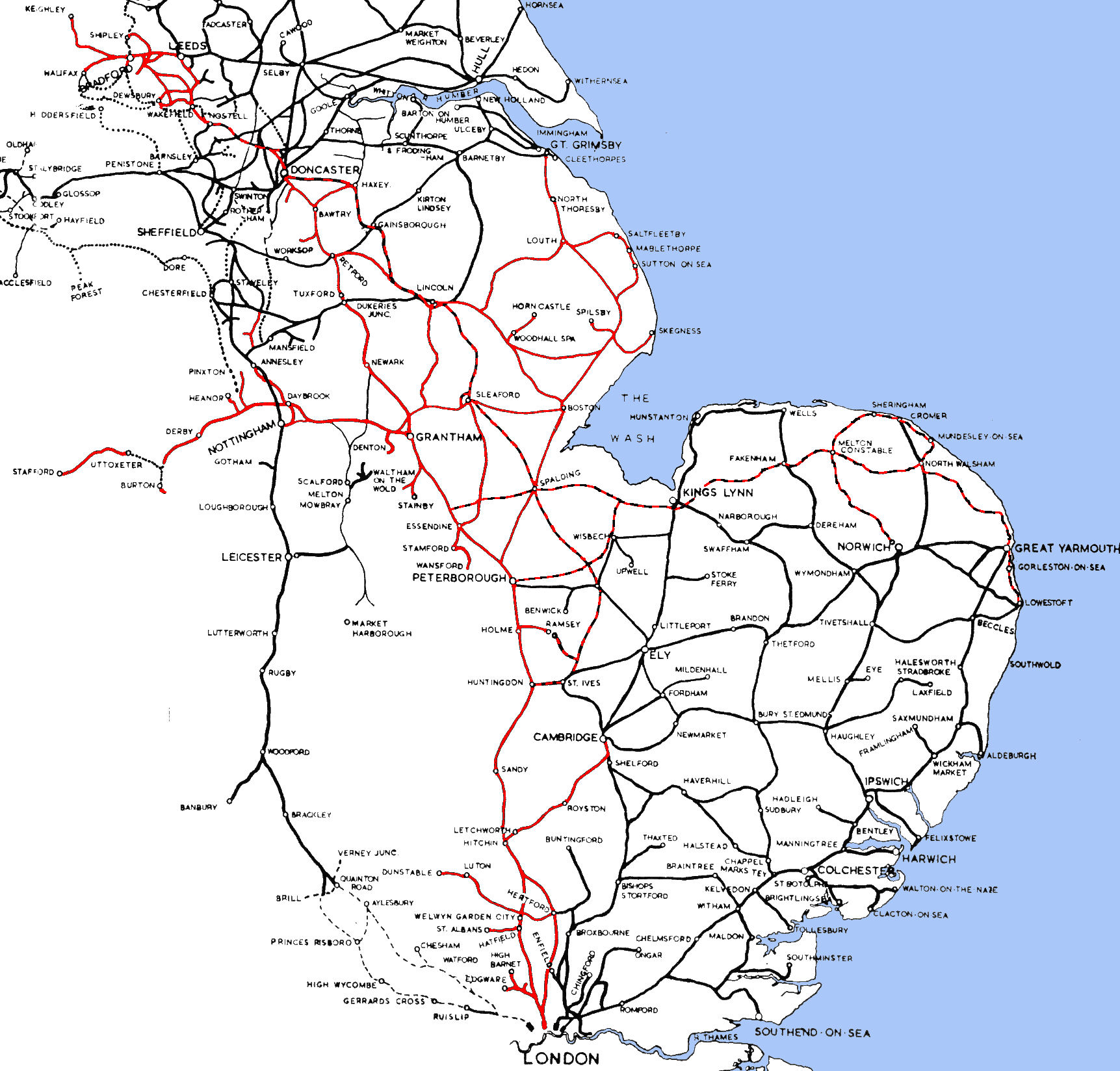
Image Source: public domain
|
GW & GCJR: Gt Western and Gt Central Junction Railway
|
merger, 1905
|
| The Great Western and Great Central Joint Railway was a railway built and operated jointly by the Great Western Railway (GWR) and Great Central Railway (GCR) between Northolt (in north west London) and Ashendon Junction (west of Aylesbury). It was laid out as a trunk route with gentle curves and gradients and spacious track layouts. The two companies each needed approach railways at both ends of the line to connect their respective systems, and these were built as part of a single project. The joint line opened in 1905 and gave the GCR a better route than previously for its London Extension from Nottingham and Leicester. When the GWR completed its "Bicester Cut-off", combined with the Joint Line itself the GWR had a much shorter and better route for its Birmingham and Birkenhead traffic.
Click here for full Wikipedia article
|

Image Source: public domain
|
GWR: Great Western Railway
|
construction, 1833
|
| The Great Western Railway (GWR) was a British railway company that linked London with the southwest and west of England, the West Midlands, and most of Wales. It was founded in 1833, received its enabling Act of Parliament on 31 August 1835 and ran its first trains in 1838. It was engineered by Isambard Kingdom Brunel, who chose a broad gauge of 7 ft (2,134 mm)—later slightly widened to 7 ft 1⁄4 in (2,140 mm)—but, from 1854, a series of amalgamations saw it also operate 4 ft 8 1⁄2 in (1,435 mm) standard-gauge trains; the last broad-gauge services were operated in 1892.
Click here for full Wikipedia article
|

Image Source: By Charles F. Cheffins - Cheffins's Map of English & Scotch Railways, 1850 (preserved at University of Chicago Digital Preservation Collection), Public Domain, https://commons.wikimedia.org/w/index.php?curid=31265064
|
HB&WRJR: Hull, Barnsley and West Riding Junction Railway
|
construction, 1885
|
| The Hull Barnsley & West Riding Junction Railway and Dock Company (HB&WRJR&DCo.) was opened on 20 July 1885. It had a total projected length of 66 miles but never reached Barnsley, stopping a few miles short at Stairfoot. The name was changed to The Hull and Barnsley Railway (H&BR) in 1905. Its Alexandra Dock in Hull opened 16 July 1885.
Click here for full Wikipedia article
|
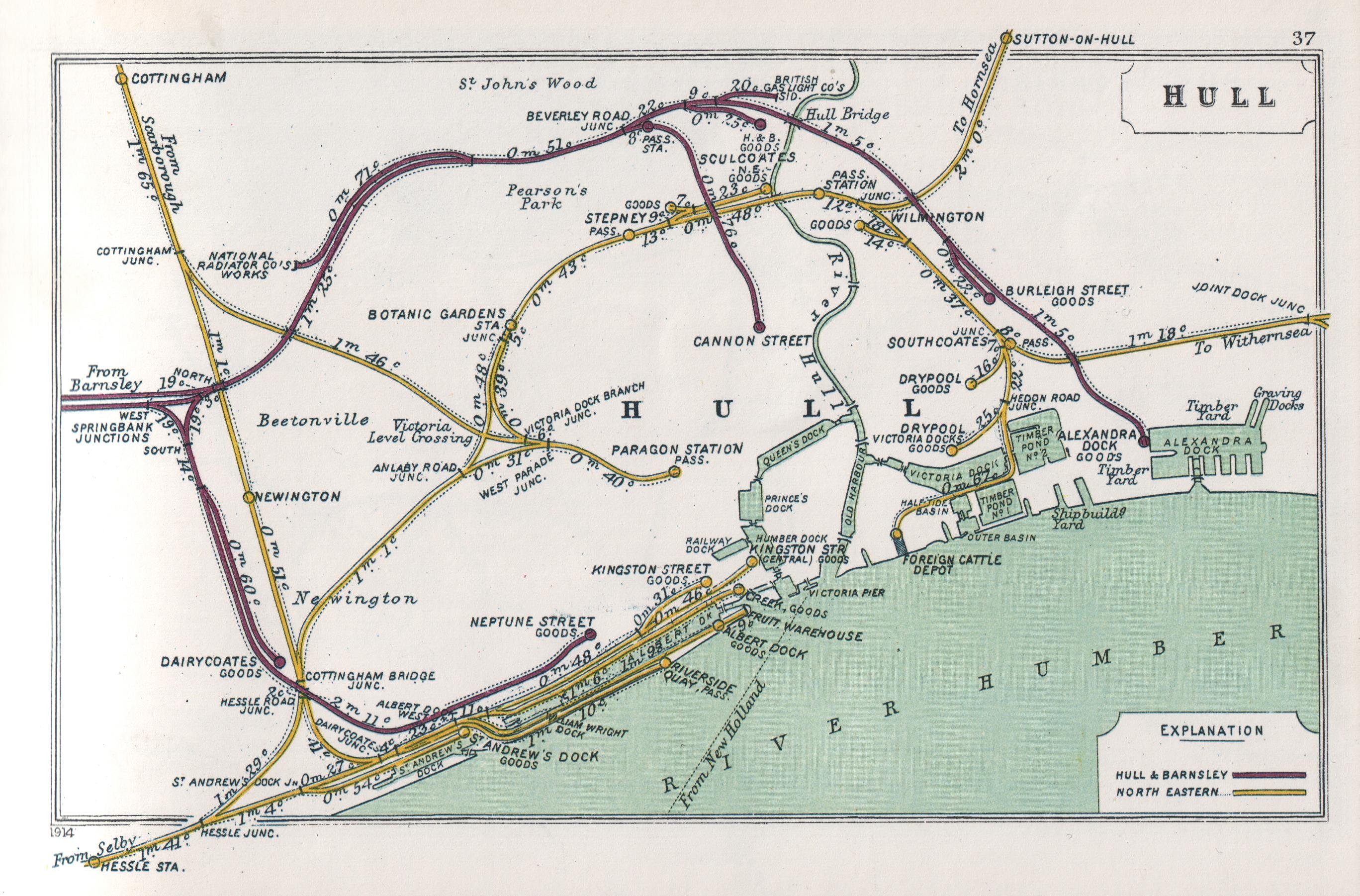
Image Source: Author died more than 70 years ago - public domain
|
HBR: Hull and Barnsley Railway
|
construction, 1885
|
| The Hull Barnsley & West Riding Junction Railway and Dock Company (HB&WRJR&DCo.) was opened on 20 July 1885. It had a total projected length of 66 miles but never reached Barnsley, stopping a few miles short at Stairfoot. The name was changed to The Hull and Barnsley Railway (H&BR) in 1905. Its Alexandra Dock in Hull opened 16 July 1885.
Click here for full Wikipedia article
|

Image Source: Author died more than 70 years ago - public domain
|
IWR: Isle of Wight Railway
|
construction, 1864
|
| The Isle of Wight Railway was a railway company on the Isle of Wight, United Kingdom; it operated 14 miles of railway line between Ryde and Ventnor. It opened the first section of line from Ryde to Sandown in 1864, later extending to Ventnor in 1866. The Ryde station was at St Johns Road, some distance from the pier where the majority of travellers arrived. A tramway operated on the pier itself, and a street-running tramway later operated from the Pier to St Johns Road. It was not until 1880 that two mainland railways companies jointly extended the railway line to the Pier Head, and IoWR trains ran through, improving the journey arrangements.
Click here for full Wikipedia article
|
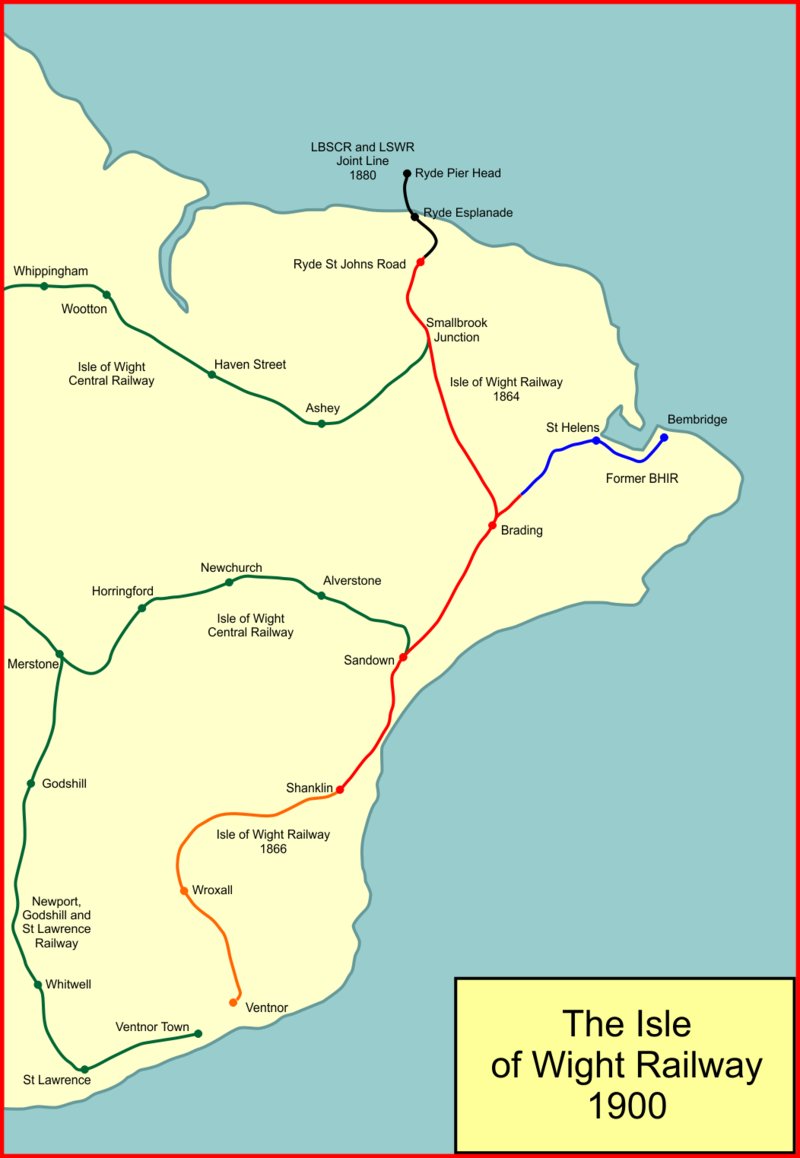
Image Source: By Afterbrunel - Own work, CC BY-SA 4.0, https://commons.wikimedia.org/w/index.php?curid=54503392
|
L&SWR: London and South Western Railway
|
construction, 1838
|
| The London and South Western Railway (LSWR or L&SWR[1]) was a railway company in England from 1838 to 1922. Starting as the London and Southampton Railway, its network extended from London to Plymouth via Salisbury and Exeter, with branches to Ilfracombe and Padstow and via Southampton to Bournemouth and Weymouth. It also had many routes connecting towns in Hampshire and Berkshire, including Portsmouth and Reading. In the grouping of railways in 1923 the LSWR amalgamated with other railways to create the Southern Railway.
Click here for full Wikipedia article
|

Image Source: Afterbrunel at English Wikipedia
|
L&Y : Lancashire and Yorkshire Railway
|
merger, 1847
|
| The Lancashire and Yorkshire Railway (L&YR) was a major British railway company before the 1923 Grouping. It was incorporated in 1847 from an amalgamation of several existing railways. It was the third-largest railway system based in northern England (after the Midland and North Eastern Railways).[
Click here for full Wikipedia article
|
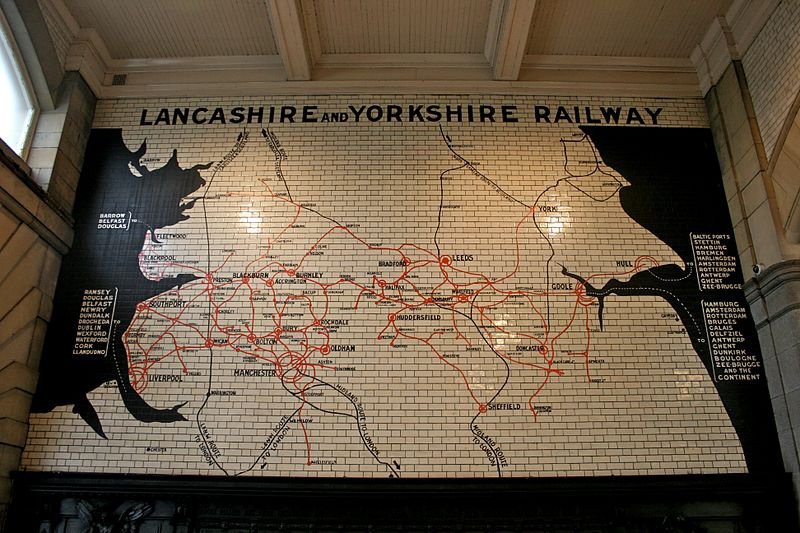
Image Source: By Photograph by Mike Peel (www.mikepeel.net)., CC BY-SA 4.0, https://commons.wikimedia.org/w/index.php?curid=7026016
|
LB&SCR: London, Brighton and South Coast Railway
|
construction, 1846
|
| The London, Brighton and South Coast Railway (LB&SCR; known also as "the Brighton line", "the Brighton Railway" or the Brighton) was a railway company in the United Kingdom from 1846 to 1922. Its territory formed a rough triangle, with London at its apex, practically the whole coastline of Sussex as its base, and a large part of Surrey.
Click here for full Wikipedia article
|

Image Source: By Das48 - Own work, CC BY-SA 3.0, https://commons.wikimedia.org/w/index.php?curid=8950793
|
LER: London Electric Railway
|
construction, 1910
|
| The London Electric Railway (LER) was an underground railway company operating three lines on the London Underground. It was formed in 1910 and existed until 1933, when it was merged into the London Passenger Transport Board.
Click here for full Wikipedia article
|

Image Source: By DavidCane - taken from File:London Underground Zone 2.png by ed g2s • talk, CC BY-SA 3.0, https://commons.wikimedia.org/w/index.php?curid=37785295
|
LMS: London Midland and Scottish Railway
|
merger, 1923
|
| The London, Midland and Scottish Railway (LMS)[a] was a British railway company. It was formed on 1 January 1923 under the Railways Act of 1921,[1] which required the grouping of over 120 separate railways into four. The companies merged into the LMS included the London and North Western Railway, Midland Railway, the Lancashire and Yorkshire Railway (which had previously merged with the London and North Western Railway on 1 January 1922), several Scottish railway companies (including the Caledonian Railway), and numerous other, smaller ventures.
Click here for full Wikipedia article
|

Image Source: Open source
|
LNE: London and North Eastern Railway
|
merger, 1923
|
| The London and North Eastern Railway (LNER) was the second largest (after LMS) of the "Big Four" railway companies created by the Railways Act 1921 in Britain. It operated from 1 January 1923 until nationalisation on 1 January 1948. At that time, it was divided into the new British Railways' Eastern Region, North Eastern Region, and partially the Scottish Region.
Click here for full Wikipedia article
|

Image Source: The Railway Magazine, January 1925.
|
LNWR: London & North Western Railway
|
construction, 1846
|
| The London and North Western Railway (LNWR, L&NWR) was a British railway company between 1846 and 1922. In the late 19th century, the L&NWR was the largest joint stock company in the United Kingdom. In 1923, it became a constituent of the London, Midland and Scottish (LMS) railway, and, in 1948, the London Midland Region of British Railways: the LNWR is effectively an ancestor of today's West Coast Main Line.
Click here for full Wikipedia article
|

Image Source: EnglandRailroads-mccorquodalegeorge-1911
|
LNWR: London and North Western Railway
|
construction, 1846
|
| (see article on London & North Western Railway)
Click here for full Wikipedia article
|
![]()
Image Source:
|
M&AR: Maidstone and Ashford
|
construction, 1880
|
| The Maidstone line is a railway line in Kent, England. The Maidstone & Ashford Railway was incorporated by Act of 12th August 1880, for the construction and maintenance of a railway, about 19 miles in length, from Maidstone to Ashford, both in the County of Kent. It diverges from the Chatham main line at Swanley Junction and proceeds down the Darenth valley to Otford junction (where the Bat & Ball line[3] divides towards Sevenoaks). It continues via Borough Green & Wrotham and Maidstone East to Ashford, where it joins the South Eastern Main Line. The line was built by the London, Chatham and Dover Railway from their first line (the Chatham main line). Upon the creation of the South Eastern and Chatham Railway the original Ashford terminus was closed in 1899 and services diverted to the South Eastern Railway's Ashford station.
Click here for full Wikipedia article
|

Image Source: By OpenStreetMap contributors - openstreetmap.org, CC BY 3.0, https://commons.wikimedia.org/w/index.php?curid=92634540
|
M&GN: Midland and Great Northern Joint Railway
|
merger, 1893
|
| The Midland and Great Northern Joint Railway (M&GNJR) was a railway network in England, in the area connecting southern Lincolnshire and north Norfolk. It developed from several local independent concerns and was incorporated in 1893. It was jointly owned by the Midland Railway and the Great Northern Railway, and those companies had long sponsored and operated the predecessor companies.
Click here for full Wikipedia article
|

Image Source: By Afterbrunel - Own work, CC BY-SA 4.0, https://commons.wikimedia.org/w/index.php?curid=66167645
|
M.CR: Maryport and Carlisle Railway
|
construction, 1836
|
| The Maryport & Carlisle Railway (M&CR) was an English railway company formed in 1836 which built and operated a small but eventually highly profitable railway to connect Maryport and Carlisle in Cumbria, England. There were many small collieries in the area and efficient access to the harbour at Maryport was important.
Click here for full Wikipedia article
|

Image Source: By Afterbrunel - Own work, CC BY-SA 4.0, https://commons.wikimedia.org/w/index.php?curid=47462302
|
M7M: Manchester and Midland Railway
|
construction, 1844
|
| The Midland Railway (MR) was a railway company in the United Kingdom from 1844.[1] The Midland was one of the largest railway companies in Britain in the early 20th century, and the largest employer in Derby, where it had its headquarters. It amalgamated with several other railways to create the London, Midland and Scottish Railway at grouping in 1922.[2]
Click here for full Wikipedia article
|
![]()
Image Source:
|
MDR: Metropolitan District Railway
|
construction, 1868
|
| The Metropolitan District Railway (commonly known as the District Railway) was a passenger railway that served London from 1868 to 1933. Established in 1864 to complete the inner circle, an underground railway in London, the first part of the line opened using gas-lit wooden carriages hauled by steam locomotives. The Metropolitan Railway operated all services until the District introduced its own trains in 1871. The railway was soon extended westwards through Earl's Court to Fulham, Richmond, Ealing and Hounslow. After completing the inner circle and reaching Whitechapel in 1884, it was extended to Upminster in Essex in 1902.
Click here for full Wikipedia article
|

Image Source: By User:Edgepedia, modified by User:DavidCane - File:Circle Line.svg, File:District Line.svg and File:Hammersmith & City Line.svg, modified, CC BY-SA 3.0, https://commons.wikimedia.org/w/index.php?curid=19464631
|
MET & GC: Metropolitan and Grand Central
|
merger, 1906
|
| On 2 April 1906, the same day that the Great Western and Great Central Joint Railway (GWGCJR) was opened, the Metropolitan and Great Central Joint Railway (MGCJR) was created. The Metropolitan and Great Central Joint Railway was a joint railway company that controlled a line extending from Harrow on the Hill in what is now north-western Greater London to Verney Junction in Buckinghamshire, England.[1] Owned by the Metropolitan Railway and the Great Central Railway, the railway was nationalised in 1948.
Click here for full Wikipedia article
|
![]()
Image Source:
|
MET RLY: Metropolitan railway
|
construction, 1863
|
| The Metropolitan Railway (also known as the Met)[note 1] was a passenger and goods railway that served London from 1863 to 1933, its main line heading north-west from the capital's financial heart in the City to what were to become the Middlesex suburbs. Its first line connected the main-line railway termini at Paddington, Euston, and King's Cross to the City.
Click here for full Wikipedia article
|

Image Source: Open source. Edgepedia, with modifications by DavidCane,
|
MR: Midland Railway
|
construction, 1844
|
| The Midland Railway (MR) was a railway company in the United Kingdom from 1844.[1] The Midland was one of the largest railway companies in Britain in the early 20th century, and the largest employer in Derby, where it had its headquarters. It amalgamated with several other railways to create the London, Midland and Scottish Railway at grouping in 1922.[2]
Click here for full Wikipedia article
|
![]()
Image Source:
|
MR: Metropolitan railway
|
construction, 1863
|
| (see artcle on MET RLY , Metropolitan railway)
Click here for full Wikipedia article
|
![]()
Image Source:
|
MSWJR: Midland & South Western Jct. Railway
|
merger, 1884
|
| The Midland and South Western Junction Railway (M&SWJR) was an independent railway built to form a north–south link between the Midland Railway and the London and South Western Railway in England, allowing the Midland and other companies' trains to reach the port of Southampton.[1] The M&SWJR was formed in 1884 from the amalgamation of the Swindon, Marlborough and Andover Railway and the Swindon and Cheltenham Extension Railway. The line was absorbed by the Great Western Railway at the 1923 Grouping and became part of British Railways on nationalisation in 1948. The railway closed to passengers in 1961, and to goods between 1964 and 1970. A small part of it has been reopened as the heritage Swindon and Cricklade Railway.
Click here for full Wikipedia article
|

Image Source: Afterbrunel - Own work
|
MTR: Unknown
|
,
|
|
Click here for full Wikipedia article
|
![]()
Image Source:
|
N&BR: Neath & Brecon Railway
|
construction, 1862
|
| The Dulas Valley Mineral Railway was incorporated in 1862 to bring coal from the Onllwyn area north-east of Neath to the quays there, and in the following year was reconstituted as the Neath and Brecon Railway. The line was opened as far as Onllwyn in 1863. The directors allowed a contractor John Dickson a free hand in building the line and when he became bankrupt the company was in a desperate financial situation. Nevertheless, the line was completed to Brecon in 1867, and an offshoot to connect with the Swansea Vale Railway, giving better access to Swansea, was ready in 1873.
Click here for full Wikipedia article
|

Image Source: Afterbrunel - Own work
|
NBR CO: North British Railway
|
construction, 1844
|
| The North British Railway was a British railway company, based in Edinburgh, Scotland. It was established in 1844, with the intention of linking with English railways at Berwick. The line opened in 1846, and from the outset the company followed a policy of expanding its geographical area, and competing with the Caledonian Railway in particular. In doing so it committed huge sums of money, and incurred shareholder disapproval that resulted in two chairmen leaving the company.
Click here for full Wikipedia article
|

Image Source: By Afterbrunel - Own work, CC BY-SA 4.0, https://commons.wikimedia.org/w/index.php?curid=46649610
|
NE: North Eastern Railway
|
merger, 1854
|
| The North Eastern Railway (NER) was an English railway company. It was incorporated in 1854 by the combination of several existing railway companies. Later, it was amalgamated with other railways to form the London and North Eastern Railway at the Grouping in 1923. Its main line survives to the present day as part of the East Coast Main Line between London and Edinburgh.
Click here for full Wikipedia article
|

Image Source: Public Domain
|
NSR: North Staffordshire Railway
|
construction, 1845
|
| The North Staffordshire Railway (NSR) was a British railway company formed in 1845 to promote a number of lines in the Staffordshire Potteries and surrounding areas in Staffordshire, Cheshire, Derbyshire and Shropshire. The company was based in Stoke-on-Trent and was nicknamed The Knotty; its lines were built to the standard gauge of 4 ft 8 1⁄2 in (1,435 mm). The main routes were constructed between 1846 and 1852 and ran from Macclesfield to Norton Bridge, just north of Stafford, and from Crewe to Egginton Junction, west of Derby. Within these main connections with other railway companies, most notably the London and North Western Railway (LNWR), the company operated a network of smaller lines although the total route mileage of the company never exceeded 221 miles (356 km).
Click here for full Wikipedia article
|

Image Source: North Staffordfshire Railway, 1904. NSR in purple; Macclesfield, Bollington & Marple Railway (Joint GCR/NSR) in yellow [Detached purple route at top is the Sheffield & Midland Joint (GCR/MR)] John Speller's Web Pages
|
S&DJR: Somerset & Dorset Joint Railway
|
merger, 1862
|
| The Somerset & Dorset Joint Railway, also known as the S&D, was an English railway line connecting Bath (in north-east Somerset) and Bournemouth (now in south-east Dorset but then in Hampshire), with a branch from Evercreech Junction to Burnham-on-Sea and Bridgwater. The Somerset and Dorset Railway (S&D) was created in 1862, as an amalgamation of the Somerset Central Railway and the Dorset Central Railway. Strictly speaking, the main line ran from Bath Junction to Broadstone, as the line between Broadstone and Bournemouth was owned by the London and South Western Railway, while the line between Bath Junction and Bath was owned by the Midland Railway.[1]
Click here for full Wikipedia article
|

Image Source: By Afterbrunel at English Wikipedia - Transferred from en.wikipedia to Commons by Oxyman using CommonsHelper., Public Domain, https://commons.wikimedia.org/w/index.php?curid=4479185
|
S&WR: Scarborough & Whitby Railway
|
construction, 1885
|
| The Scarborough & Whitby Railway was a railway line from Scarborough to Whitby in North Yorkshire, England. The line followed a difficult but scenic route along the North Yorkshire coast. The line opened in 1885 and closed in 1965 (see Beeching Axe). The route, now a multi-use path, is known as "The Cinder Track".
Click here for full Wikipedia article
|

Image Source: By Maniac Pony, CC BY 2.5, https://commons.wikimedia.org/w/index.php?curid=7247391
|
SE&CR: South Eastern & Chatham Railway
|
merger, 1899
|
| The South Eastern and Chatham Railway Companies Joint Management Committee (SE&CRCJMC), known as the South Eastern and Chatham Railway (SE&CR), was a working union of two neighbouring rival railways, the South Eastern Railway (SER) and London, Chatham and Dover Railway (LC&DR), which operated between London and south-east England. Between 1899 and 1923, the SE&CR had a monopoly of railway services in Kent and to the main Channel ports for ferries to France and Belgium.
Click here for full Wikipedia article
|

Image Source: By Clem Rutter, Rochester, Kent. - Own work, CC BY 2.5, https://commons.wikimedia.org/w/index.php?curid=2135108
|
SER: South Eastern Railway
|
construction, 1836
|
| The South Eastern Railway (SER) was a railway company in south-eastern England from 1836 until 1922. The company was formed to construct a route from London to Dover. Branch lines were later opened to Tunbridge Wells, Hastings, Canterbury and other places in Kent.
Click here for full Wikipedia article
|

Image Source: By F Wishaw - From Whishaw, F, (1840) The Railways of Great Britain and Ireland: Practically described and illustrated London: Simpkin, Marshall and Co., Public Domain, https://commons.wikimedia.org/w/index.php?curid=2836079
|
SYJR: South Yorkshire Joint Railway
|
merger, 1903
|
| The South Yorkshire Joint Railway was a committee formed in 1903, between the Great Central Railway, the Great Northern Railway, the Lancashire and Yorkshire Railway, the Midland Railway and the North Eastern Railway to oversee the construction of a new railway in the Doncaster area of South Yorkshire, England. The five companies had equal rights over the line, each of the companies regularly working trains over it.
Click here for full Wikipedia article
|

Image Source: By Railway Clearing House - Railway Junction Diagram, Public Domain, https://commons.wikimedia.org/w/index.php?curid=3479303
|
TVR: Taff Vale Railway
|
construction, 1840
|
| The Taff Vale Railway (TVR) was a standard gauge railway in South Wales, built by the Taff Vale Railway Company to serve the iron and coal industries around Merthyr Tydfil and to connect them with docks in Cardiff. It was opened in stages in 1840 and 1841.
Click here for full Wikipedia article
|

Image Source: By Afterbrunel - Own work, CC BY-SA 4.0, https://commons.wikimedia.org/w/index.php?curid=60963190
|
W&E RLY: Watford and Edgware Railway
|
no construction, 1860
|
| The Watford and Edgware Railway (W&ER) was a company established in the 1860s in the United Kingdom to build a railway between Edgware in North London and Watford, Hertfordshire, via Bushey. Its planned 6.25-mile (10.06 km) route would have extended the railway line which forms part of the present-day Northern line on the London Underground network. Nothing substantial was constructed.
Click here for full Wikipedia article
|
![]()
Image Source:
|
WLR: West London Railway
|
construction, 1844
|
| The West London Railway was conceived to link the London and Birmingham Railway and the Great Western Railway with the Kensington Basin of the Kensington Canal, enabling access to and from London docks for the carriage of goods. It opened in 1844 but was not commercially successful.
Click here for full Wikipedia article
|

Image Source: By Afterbrunel - Own work, CC BY-SA 3.0, https://commons.wikimedia.org/w/index.php?curid=22920138
|
WM&CO RLY: Wrexham Mold and Connah's Quay Railway
|
construction, 1862
|
| The Buckley Railway was opened from Buckley to a connection with the Chester to Holyhead main line in 7/6/62, to convey coal and finished brickworks products from the Buckley area. Numerous short tramroads had existed in the area fron the 1700s. The line was steeply graded (1 in 28 between Northop Hall and Connah's Quay) and sharply curved. The Wrexham, Mold and Connah's Quay Railway (WM&CQR) was incorporated in 1862 to build a line from Wrexham to Buckley, continuing to the C&HR main line via the Buckley Railway, which it joined at Ashton's Branch Junction. It later bought the Buckley Railway. The WM&CQR had plans for extensions but was unable to raise money to bring all of them into being. Short branches to mineral workings around Brymbo were opened.
Click here for full Wikipedia article
|

Image Source: By Afterbrunel - Own work, CC BY-SA 4.0, https://commons.wikimedia.org/w/index.php?curid=77688924
|








































